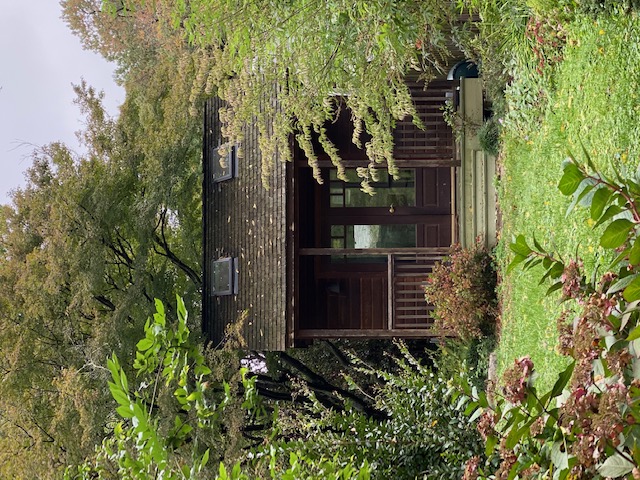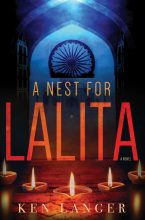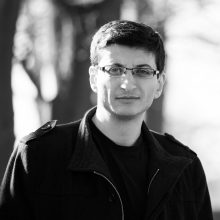A Nest for Lalita by Ken Langer
What led you into writing?
I’ve always written nonfiction, whether it was my Ph.D. dissertation, academic articles, reports on international development, or promotional materials for the green building-consulting company I founded. When I sold my company in 2012, I was browsing my bookshelf and came across the ten “India” journals I had kept ever since I landed in Varanasi as a college student. There were so many entries describing extraordinary people and experiences. It gave me the idea to write a novel set in India.
I thought I could come up with a simple plot and string together hundreds of entries from the journals, like the flowers of a garland held together by a string (what an appropriate Indian metaphor!). I dusted off the journals, set them on my desk, and started writing a preface. Three years and three hundred eighteen pages later, I realized I hadn’t cracked one journal. Thank God. The novel would have been terrible had I followed my original plan!
How does a typical day look?
I get up, check my email, kill a few brain cells on social media, meditate, eat breakfast, tank myself up with a thermos of coffee and head to my “man cave,” a wooden cabin I built five years ago in my backyard. There, glued to my desk, I write all morning. In the afternoon, I generally do things for myself — at least an hour devoted to practicing my cello, exercise, and that dreadful list of chores. I’m working on Beethoven’s five sonatas for cello and piano. My evenings are spent reading; but, by 10 p.m., I’m ready to pour myself a stiff bourbon, turn on Netflix, and watch a good murder mystery.
In what ways do your characters test your abilities?
By being so different from myself. In my novel, the main characters are an Indian woman social activist, her feminist/gay deputy, her misogynist husband, and an American architect. There’s also an eccentric Hindu priest. Aside from Simon, the architect, everyone’s quite different from me. It helps to think of real people I’ve met – people who embody key traits of the characters I’m portraying. While living in India, I’ve been fortunate to meet some truly eccentric characters. People who live in the crevices of the country, so to speak. Definitely not the folks one meets on a two-week tour.
What’s your setup?

As mentioned, I work in a 10 foot by 10-foot wood cabin, what I call my “man cave”, away from kids, loud music, and other distractions. But there are many windows which look out onto a lovely garden. But I’m such a type A personality that once I start working, I rarely look up, much less smell the roses. Four hours can go by before I realize my stomach’s yelling at me.
What lasting effects have your favourite authors had on your writing and style?
I get bored easily, so I like fast-paced novels. But I also like to think, so they have to be intelligent. I’m a big fan of John le Carré – what intelligent reader isn’t? – and I think I’ve read The Constant Gardener three times. Anne Patchett, Salman Rushdie, and Aravind Adiga are also favorites whose styles have influenced my writing.
I also devour classics, those 1000-page doorstoppers, especially where the protagonist is imperfect, a real “mensch,” and finds his way of coping in a broken world. Don Quixote and Peer Gynt, and good old Gilgamesh are good examples. I tend to learn from these characters, since I’m also prone to anguish over all the pain and suffering in the world. I guess that’s why I identify with my character Kesh (aside from his attitude toward women). As Simon realized, Meena’s husband is overly sensitive to the social ills around him; his acerbic humour is a way of coping in a world full misery.
In terms of style, I like punchy, conversational prose. The kind one finds in Hemingway or Adiga. Nothing baroque, like Faulkner. Writing should have rhythm, different tempos, and not be one long adagio. I know brilliant authors whose novels are written in beautify 19th century prose. One friend’s novel was so perfect it was boring as hell.
And I like voices that are eccentric. In my novel, Kesh and the local temple priest are examples. At one point, Simon is listening to Kesh jabber on about this and that subject, hoping the man would just shut up. Simon then notices that Kesh hasn’t blinked in a long time. “Not only did Kesh’s jabbering seem to be one run-on sentence,” thought Simon, “but his eyes, too, appeared to lack punctuation.”
What do you do for inspiration?
I go into nature and hike. When that doesn’t work, I listen to cello music, someone like YoYo Ma or Steven Isserlis, whose cellos seem to be plugged directly into their hearts. Drinking lots of coffee may not inspire me, per se, but it gets me to my desk and pretty soon my fingers are doing salsa on the keypad.
What repeating themes do you find yourself pulling into your stories?
Social injustice, for one. The major theme in my novel is the tension or even conflict between Meena and the Hindu party that is funding her new campus. On the one hand, there’s the ultra-right-wing Hindu Democratic Party (HDP), which is trying to turn the clock back on women; on the other, Meena, who is bent on moving the country into the modern world; the #MeToo movement, if you will. It’s a tug of war. I wrote a short story called The Embalmer, which takes place in Beijing immediately after Mao Zedong’s death. An embalmer is called in to work his magic on the Great Leader. But the embalmer’s relatives have been killed in Mao’s purges. While preparing Mao for his crystal casket, he takes his revenge on the corpse. I’m not sure the Chinese government would like that story.
How do you wind down?
Practicing Bach’s Suites for Unaccompanied Cello, gardening, reading, and (after all’s done) watching a good murder mystery, bourbon in hand!
What sort of challenges do you regularly overcome while designing your world/setting?
My biggest challenge is getting the facts right, since my work often goes deeply into highly sensitives subjects, such as Hindu nationalism or religious rites. For example, in my novel, the Hindu Party is trying to bring back devadasis, generally translated as temple dancers, who have been outlawed by the British. But a devadasis job description goes well beyond dancing. In fact, they are critical actors in esoteric Hindu rituals, often performed in darkness in the inner sanctums of temples. These rituals are sometimes sexual in nature, at least in the eyes of Westerners. Gita, Meena’s deputy, goes to meet a German Ph.D. student who is writing her dissertation on these rituals. She wants to know if the HDP’s plan for the devadasis is kosher, if you’ll excuse the mixed metaphor. What follows is a heated discussion about the nature of devadasis and the rituals in which they partake. The details need to be absolutely correct, lest I offend a billion people in India.
What are you reading at the moment?
Homeland Elegies, by Ayad Akhtar. I just finished Runaway Horse (actually, the original, Das Fliehendes Pferd), a 1979 novel by Martin Walser and Lee Siegel’s Love in a Dead Language, a New York Times Notable Book of the Year. Lee is a fellow Sanskrit scholar who writes brilliant prose. Talk about a punchy style. He’s as clever and funny as can be, while still being erudite. It’s a rare combination.
What’s the most useful advice you could give to an aspiring author?
Grow elephant hide – thick skin may not be enough. Even excellent writers get hundreds of rejection emails before a short story or novel is accepted by an agent, much less a publisher. It can be very discouraging. And even if an author gets published, he or she may sell very few books, unless the author spends all day on social media tooting his or her horn. So, my advice? Write for yourself and only if you enjoy the act of writing. If you’re doing it for any other reason, you’re asking for trouble.
Tell us about the book you’re promoting.
A Nest for Lalita is about an Indian woman, a social activist, who runs a home for women who have survived domestic violence. She plans to expand by building a new campus, but the stock market crashes and she loses her funded. The ultra-right-wing Hindu Democratic Party, which is vying for power, steps in with a large grant, thinking it will help them win the women’s vote. Meena is wary of taking money from the nationalist party, but she has little choice.
When Simon Bliss, America’s top “green” architect, lands in India to design her new community center, he immediately falls for the smart and alluring Meena. As the months go by, Meena’s worst fears are realized as the HDP, which has come to power, tries to turn the clock back on women. Increasingly, she finds herself locked in the HDP’s chokehold.
In his attempt to loosen the HDP’s grip on Meena and win her affection, Simon spars with reactionary politicians, crooked priests, and sleazy businessmen who will stop at nothing to protect their interests. In the process, Simon comes face to face with disturbing truths about his own past, and Meena finds herself trapped in a way she could have never expected.
That’s the plot, but A Nest for Lalita is much more – it’s a story of forbidden love set against the backdrop of an ancient country trying to find its identity in a rapidly changing world. Moreover, the prose is brimming with reflections on Sanskrit poetry, allusions to Hindu mythology, philosophical reflections on temple architecture, descriptions of secret Hindu rituals, and more. And the mood of the novel often shifts between political drama, comic relief, and philosophical reflection. I hope readers won’t rush through the book. In my unbiased opinion, it’s a work to be savoured.
👋 Hi! I run Author Interviews
As a new writer I found myself itching to contribute to a thriving, creative community, so I made Author Interviews and I've met loads of wonderful people in the process. You can buy my debut fantasy RINGLANDER: THE PATH AND THE WAY from Amazon.





